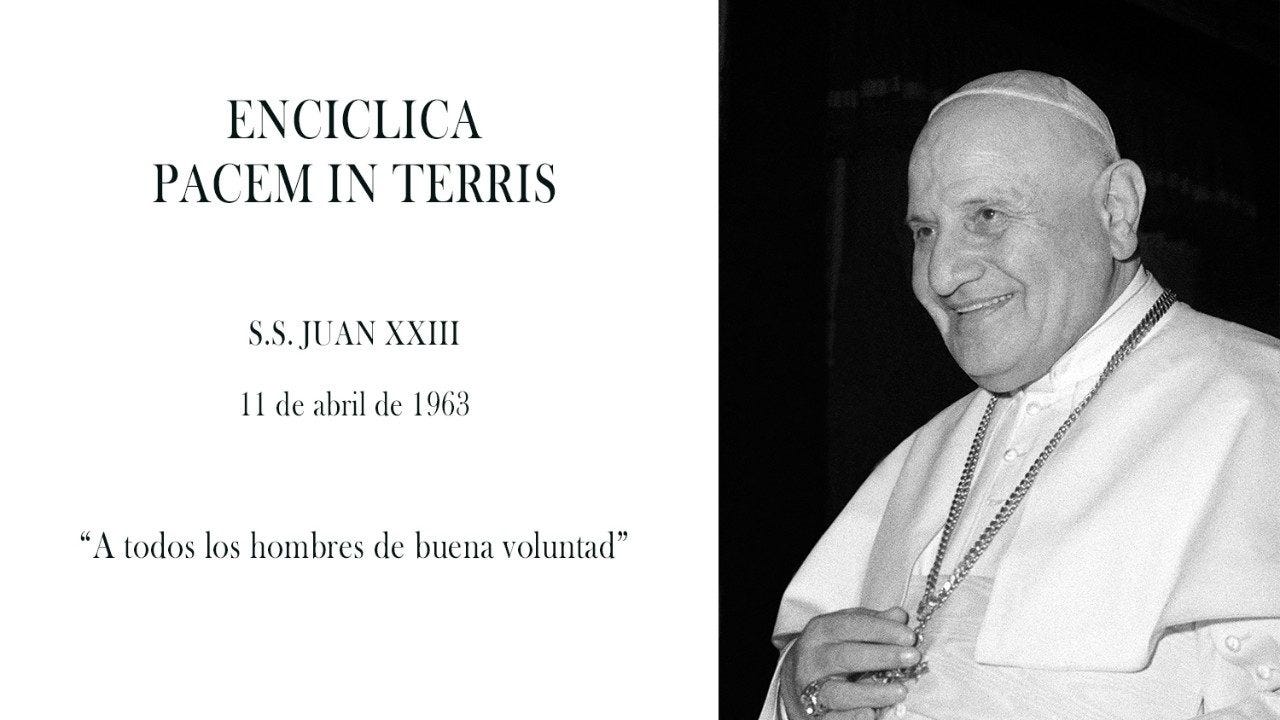"WWIII Piecemeal" - Pacem in Terris - A New World Order?
Pacem in Terris "Peace on Earth" was a papal encyclical issued by Pope John XXIII on April 11, 1963.
It was the eighth encyclical of Pope John XXIII.
The encyclical was a call for a world without victims or executioners.
It was written during the Cold War, the Berlin Wall was built, and the Cuban Missile Crisis had the entire world on edge.
The Catholic Social Teaching documents using the See-Judge-Act method laid out in Pope John XXIII's encyclical Mater et Magistra furnish the primary lens to understand the core philosophy within Pacem in Terris.
It may be time to dust off those two encyclicals off the shelf and, in our learning circles, discuss three aspects of Pacem in Terris: methodology, social teaching, and optimism in the context of today's world, the crisis we face as humans.
Pope Francis has warned that a "piecemeal" World War III may have already begun with the current conflicts in several parts of the world as we witness daily crimes, massacres, and destruction.
The encyclical Pacem in Terris addresses the rights and obligations of people and their states and proper interstate relations. The encyclical states that Only God can see and judge the hidden designs of men's hearts.
Relationships must be harmonized in truth, justice, solidarity, and liberty.
Each person has the right to life and the means necessary to live.
Humanity has a natural right to be respected, worship God, live as they choose, work and support a family, form associations, emigrate, and take an active role in public life.
The encyclical proposed a "new world order" to be built on four pillars:
Authenticity and Veracity
Virtue and Fairmindedness,
love, and
freedom.
It radically affected Catholic Social Teaching on issues such as:
War and peace
Church-state relations
Women's rights
Religious freedom
International relations
In Pacem in Terris section #9, we read: "Any human society, if it is to be well-ordered and productive, must lay down as a foundation this principle, namely, that every human being is a person, that is, his nature is endowed with intelligence and free will. Indeed, precisely because he is a person, he has rights and obligations flowing directly and simultaneously from his very nature. And as these rights and obligations are universal and inviolable, they cannot be surrendered."
Try taking that section of Pacem in Terris, and in your groups or learning circles, discuss:
The awareness (See). Start with your experiences and know-how of each other and how you view the world situation. What do you see? What is happening that is not in the context of the greater good? Ask yourself if, among all the people we encounter, we find a linking of Faith with Action in resolving the issues at hand.
Can you identify the patterns in your analysis (Judge) as a group? Why is this happening? Who thinks they are benefiting from the action? In what ways are the vulnerable impacted, and to what degree?
Continue your analysis, and add new information and ideas linked to the patterns you identified in what everyone knows and has expressed. What ideas, models, or patterns will successfully resolve the problem? Who is inspirational? Can that person lead the necessary change?
Your discussions should challenge all the unequal power relationships and assumptions involved.
Action. How do you suggest creating a plan to apply what's been discussed and learned and assist others in spreading the message through a set of practice skills, strategies, and plans for action at our local level?
Try to take a "Franciscan perspective" in your discussion to emphasize the love of God, enfleshed in Christ, as the center of reality. The "Franciscan heart" believes that:
God exists as a community of love through the Trinity.
God is loving.
We are all one in God's image. It is the likeness we humans screw up.
All of creation is the place to encounter God.
Living more simply on the earth and with others is necessary to experience and savor God's gift of life. (This is the essence of the Kingdom of God.)
The study of theology is personal and experiential. It should lead us to see the greater good.
A thing can only be fully known when we grasp its individuality and uniqueness.
St. Francis taught his followers, both women and men, to follow the path of Jesus Christ, living as he might have lived in our current world and our situation in time. In our world, people discover the Universal Christ among us in many ways. Often, there is more than one way of thinking, living, or approaching theology. This is why we employ the See-Judge-Act method.
St. Francis, Pope Francis, and St. Pope John XXIII understood the meaning of the Sermon on the Mount. We do not find a "creed" buried in the Sermon on the Mount, but we see Jesus telling us what to do—leaving it up to each of us as a community to make it happen, to bring the kingdom of God here and now the best we can.
Pacem in Terris and the Sermon on the Mount have many things in common:
Simplicity.
Harmony and peace.
Compassion.
Hope, perseverance, and resilience.
Reconciliation.
Service and stewardship.
Prayer and reflection.
We must work, think, pray, and act together to bring the Kingdom of God here and now. The See-Judge-Act method is our framework for creating our plan of action.
As Pope Francis said: "Humanity needs to weep, and this is the time to weep," let the weeping open our minds and hearts to bring about action for the greater good.
Photo courtesy of Vatican News.


